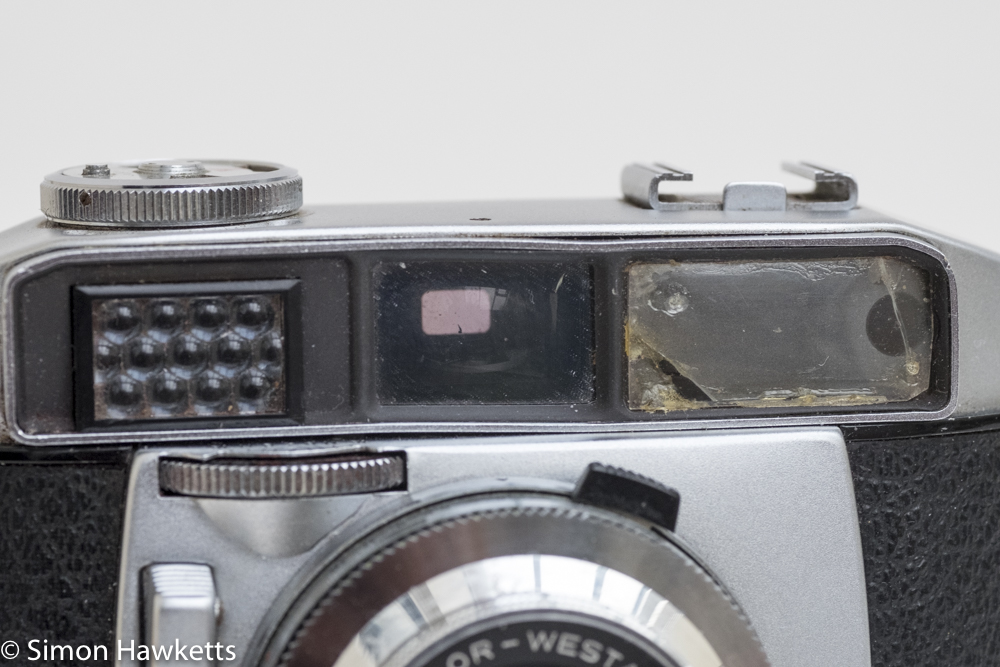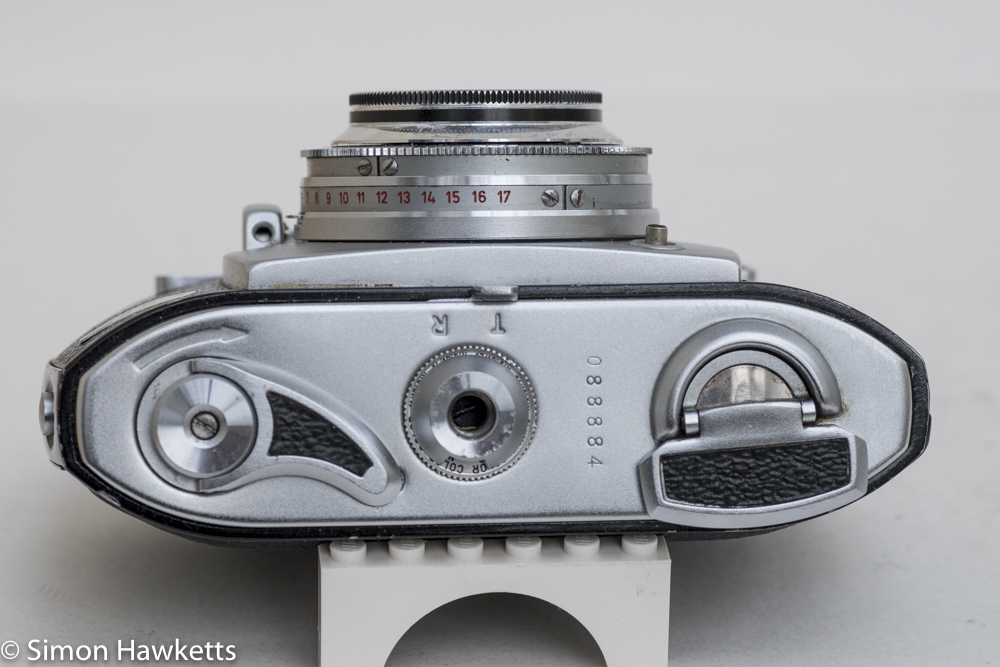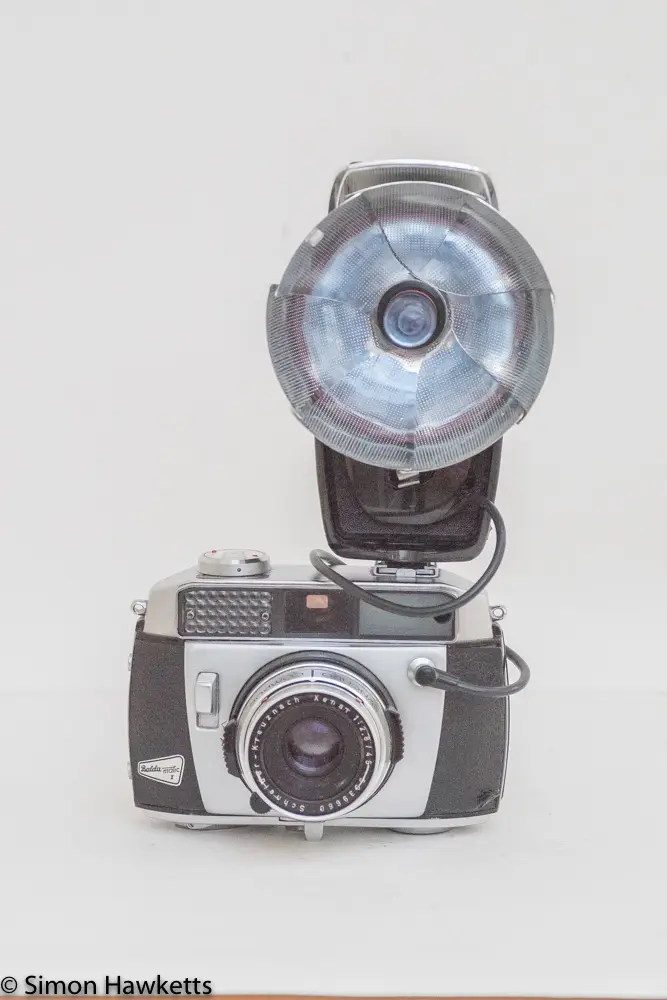Balda Baldessa 1B rangefinder camera
The Balda Baldessa 1B is a 35 mm coupled rangefinder camera with built-in light meter and a rather unusual focus control and film advance placement. It was made in about 1958 (as I was, oddly enough) and has a rather nice, curvy feel.
My Balda Baldessa 1B Camera
I paid a few pounds for this camera a couple of months ago and bought it as a non-working unit, so I could get some practice with my camera repair skills. At the moment it is still broken, so I will report on how I fixed it in the next part of this series.
The actual fault with the unit I bought is to do with the film advance and shutter cocking. When the key on the bottom of the camera is turned, it doesn’t correctly cock the shutter and gets locked. Then, if the shutter is pressed, the key unlocks, but the shutter doesn’t actually fire. Oddly, if I hold the shutter release down I can wind the film advance key and at a certain point the shutter fires and runs down the correct length of time. I suspect there is some timing issue or dirt in a mechanism somewhere.
Other than the mechanical problem with the shutter, the glass in front of the rangefinder window looks cracked, although in fact it is a plastic window and is creased rather than cracked. The name tag on the front of the camera is also a little worse for wear, with the transfer being almost completely worn off.
There are some positives, however; the light meter still responds to light and the range finder is quite bright and smooth in operation. Also, when it works, the shutter timing seems about right and the aperture adjusts nicely.
Pictures of the Balda Baldessa 1B









Balda Baldessa 1B Description
As I said above, although the Baldessa has a similar spec to many other 35 mm rangefinder cameras available in the late 1958 it does have a rather different control layout from the norm.
The light meter is of the non-coupled variety.
There is a light cell on the front of the body which measures the light reflected from the subject, moving a meter needle in the top panel just above it. Next to the meter needle window is a dial which is adjusted so a red arrow lines up with the meter needle and then the correct exposure is read from the dial.
The light meter and camera are designed to work with the EV (Exposure Value) system, so the value read from the light meter is a simple number which is transferred to the camera exposure system. Once set, the aperture and shutter speed are locked together, although a number of different combinations can be selected, any of which will result in the same exposure. It’s a bit like Program Shift on a modern digital camera and allows the photographer to make an artistic choice whilst keeping the exposure right.
The focus is not adjusted by turning the front element of the lens, but with a dial set into the top of the front section of the camera that the lens is mounted on. Although this is a bit unconventional, it actually works quite nicely because the finger used for the shutter release is naturally in the correct position to turn the dial. There is a readout on the top of the dial which gives you the distance after the camera is focused and also a depth of field scale, but I suspect these are there for convenience when using flash because the rangefinder itself is fully coupled to the lens.

The bottom of the camera is where the film advance, rewind and film type reminder are arranged. The film advance is a key arrangement rather than a quick advance lever, so it needs to be lifted and wound to advance the film and cock the shutter. This makes it slower to use than some other cameras available at the time, but I suspect people didn’t fire off 10 shots of the same subject in the late ’50s, so it was probably fine.
The rewind control is locked into the bottom of the camera with a small lever at the front of the camera and when it is open it’s a nice large control which would make the rewind operation quite smooth.
Around the tripod bush is a film type reminder which is turned with a knurled rim around the outside of the bush. It lists the likely film types and speeds available at the time the camera was made. There is a count-down frame counter which is just visible under the film advance key, but it’s hidden until the key is hinged up.
Overall, this is quite a nice camera in the hand. The curved body fits well and although the controls are laid out somewhat unconventionally, for the most part they are easy to use and quite effectively placed.
I’m hoping that I can fix the issues with the film advance and shutter cocking, and if I do, I’ll write an article with some details.
Balda Baldessa 1B specifications
- Balda Baldessa 1B 35 mm rangefinder camera
- Uncoupled light meter
- ASA range 6 to 6400
- Coupled rangefinder with focus control on front of camera
- Unconventional film advance key on base of camera
- Film type reminder built round tripod base
- Isco-gottingen color-westanar 45 mm f/2.8 lens
- Prontor SVS shutter
- X & M flash sync
- Mechanical 10 sec Self timer
- EV exposure system
- Accessory shoe
- Shutter speeds 1 sec to 1/300 sec
- Apertures f/2.8 to f/16
- EV settable from 2 to 17
- Serial No: 088884
- Manual available on-line here
Discover more from Everything Vintage
Subscribe to get the latest posts sent to your email.





